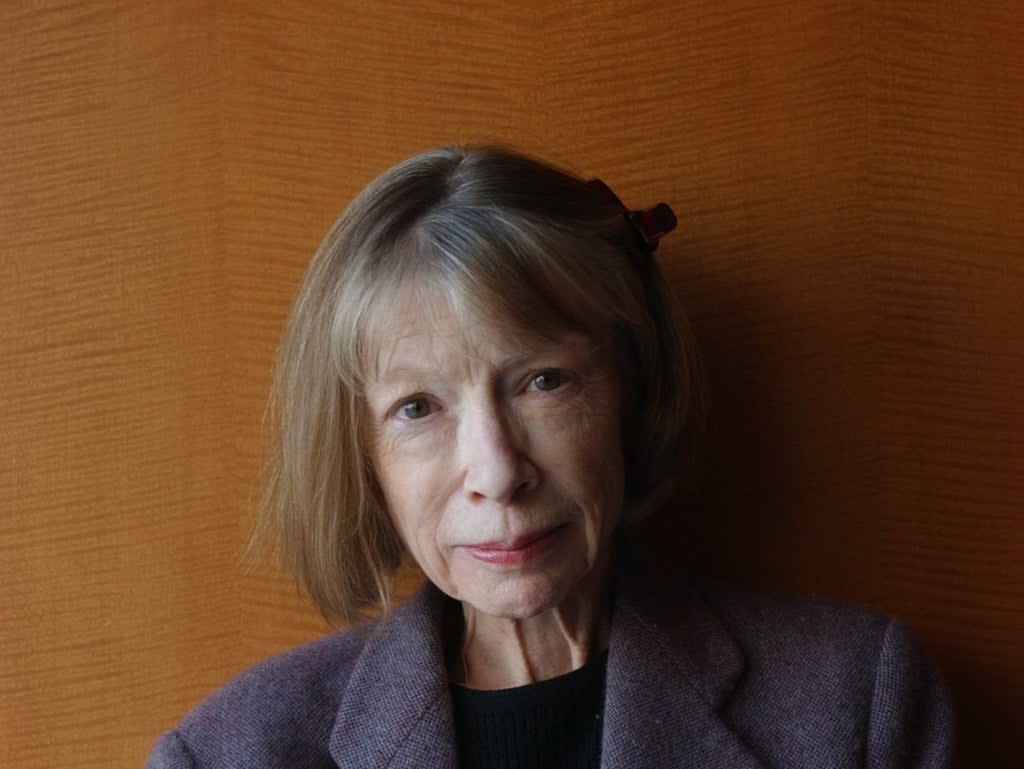Joan Didion: Let me tell you, she was gold

- Oops!Something went wrong.Please try again later.
Joan Didion, who died today in New York at the age of 87, was a writer all her life. Her work, whether fiction or journalism, was clear-sighted, precise and perceptive, and always peppered with her signature bone-dry wit. “Had I been blessed with even limited access to my own mind there would have been no reason to write,” she explained in her 1976 essay “Why I Write”. “I write entirely to find out what I’m thinking, what I’m looking at, what I see and what it means. What I want and what I fear.”
Born on 5 December 1934 in Sacramento, California, Didion was just five years old when she wrote her first story, at her mother’s encouragement. As a teenager she obsessively typed out the works of Ernest Hemingway, learning the rhythm and simplicity of clear, declarative writing. At 21, while studying for a degree in English at Berkeley, she wrote an essay about the San Francisco architect William Wilson Wurster and entered it into a competition sponsored by Vogue. She won first place, and her prize was a job as a research assistant at the magazine and the start of a new life in New York.
Didion spent seven years at Vogue, working her way up to the position of associate feature editor, but found herself homesick for California. In 1963, she published her first novel, Run, River, which centres on the lives of the great-grandchildren of California’s pioneers. Looking back at the novel later, in her 2003 essay collection Where I Was From, Didion saw the book as a work of false nostalgia, portraying an idyllic version of California that may never have existed.
Her friend John Gregory Dunne, a fellow writer, helped her edit the book and they married a year later. After returning to California, the couple made their living writing magazine articles, but by 1967 the social upheaval in the state and the country at large had made the then 32-year-old Didion doubt herself. When The Saturday Evening Post dispatched her to report on the Summer of Love in San Francisco, she went, she later wrote, “because I had not been able to work in some months, had been paralysed by the conviction that writing was an irrelevant act, that the world as I had understood it no longer existed. If I was to work again at all, it would be necessary for me to come to terms with disorder.”
It was disorder she found and chronicled in San Francisco, in stark contrast to the utopian image presented by those involved in the counterculture. In one of the most startling moments in her essay “Slouching Towards Bethlehem”, which gave its title to a 1968 collection of her magazine work, she encounters a five-year-old girl named Susan who is tripping on LSD provided by her parents. She recalled this seemingly shocking moment in the 2017 documentary Joan Didion: The Center Will Not Hold, directed by her nephew Griffin Dunne. “Let me tell you, it was gold,” Didion told Dunne with delight. “You live for moments like that, if you’re doing a piece. Good or bad.”
This restrained detachment, coupled with a piercing gaze that refused to look away, defined Didion’s style. She retained that same sense of cool scrunity even when turning her gaze on herself. In the title essay of her 1979 collection The White Album, Didion documents her own nervous breakdown a decade earlier. She writes of undergoing a psychiatric evaluation, after which she was diagnosed as having had an attack of vertigo and nausea. “By way of comment,” she wrote, “I offer only that an attack of vertigo and nausea does not now seem to me an inappropriate response to the summer of 1968.”
During the Seventies, Didion wrote and published several more novels, including 1970’s Play It As It Lays, a spare, elegant tale about a woman confined to a psychiatric hospital. When the book was adapted into a film in 1972, Didion and Dunne themselves wrote the screenplay. The couple ended up among the most highly paid screenwriters in Hollywood, and their work included the 1976 adaptation of A Star Is Born with Barbra Streisand and Kris Kristofferson, and 1981’s True Confessions, based on Dunne’s own Los Angeles-set crime novel.
On 30 December 2003, while their adopted daughter Quintana Roo Dunne was in a coma, Dunne had a heart attack at the dinner table and died. Less than a year later, on 4 October 2004, Didion sat down to write about navigating grief while dealing with her daughter’s severe illness. 88 days later she emerged with The Year of Magical Thinking, still regarded as one of the essential works about grief and mourning. “A single person is missing for you, and the whole world is empty,” she wrote. The book was nominated for a Pulitzer Prize and won the 2005 National Book Award for Nonfiction. On 26 August 2005, while promoting her book in New York, Didion learned that her daughter had died of acute pancreatitis. Again, rather than turning her gaze away, Didion wrote candidly about this experience in her 2011 work Blue Nights.
Throughout her life, Didion drew powerful narratives out of the chaos and disorder of American culture. She understood the power that stories have, not just to tell us about our lives, but to shape them. As she wrote in the opening paragraph of “The White Album”: “We tell ourselves stories in order to live … We look for the sermon in the suicide, for the social or moral lesson in the murder of five. We interpret what we see, select the most workable of the multiple choices. We live entirely … by the imposition of a narrative line upon disparate images, by the ‘ideas’ with which we have learned to freeze the shifting phantasmagoria – which is our actual experience.”

